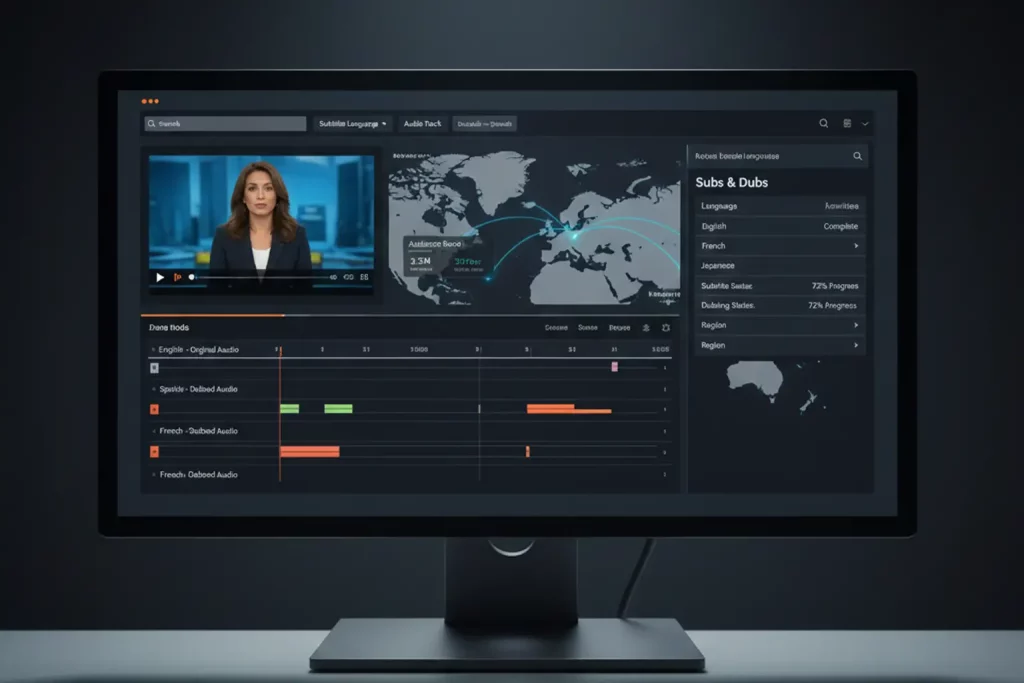Media management is integral to the success of the broadcasting industry, where handling vast amounts of diverse content is a daily necessity. From raw footage to finished programming, scripts, and intricate graphics, broadcasters manage an immense volume of assets. Streamlined workflows ensure this content is efficiently organized, accessed, and delivered. The importance of effective media asset management must be balanced. It enhances operational efficiency, reduces overall costs, and provides timely content. Broadcast companies rely on sophisticated media systems that can process these large volumes of assets without disruption, ensuring smooth content retrieval, storage, and distribution.
The Core Components of Media Management
Asset Acquisition
The process of managing broadcast media begins with asset acquisition. This stage involves gathering raw footage, scripts, graphics, and other essential components for production. It requires proper planning and a strategic approach to ensure all necessary media elements are in place before production begins. The acquisition of assets is the foundation of any successful broadcast, ensuring that the creative vision has the right materials to be executed seamlessly. Properly managed asset acquisition integrates these elements into a cohesive broadcast, setting the stage for efficient media management.
Content Storage and Management
After content assets are acquired, storing and managing them effectively becomes crucial. At Digital Nirvana, we utilize MIQ to store and organize content, ensuring seamless access and retrieval for our clients. Our approach focuses on content management within a structured environment, offering controlled access and optimized performance for specific needs. With MIQ, we ensure content is securely stored and easily accessible, providing the flexibility and efficiency required by broadcasters and media professionals.
Retrieval and Access
Efficient retrieval and access to media assets are fundamental to streamlined media management. Organizing content to make it quickly searchable and accessible saves time and boosts productivity. Broadcast teams need immediate access to specific content for editing, repurposing, and distribution. Properly structured retrieval systems allow for a faster turnaround in production, empowering broadcasters to focus on creating quality content rather than spending time locating assets. Effective media management tools ensure broadcasters can easily access what they need exactly when needed.
How Digital Nirvana Supports Media Management for Broadcasters
At Digital Nirvana, we are committed to supporting broadcasters with cutting-edge solutions that simplify media management. Here’s how we help:
- We automate metadata generation with our MetadataIQ tool, making content management more efficient and allowing quick retrieval of files from extensive media libraries.
- Our MonitorIQ product provides advanced logging and tracking, ensuring broadcasters comply with all industry regulations.
We streamline media management processes to enhance operational efficiency, enabling broadcasters to focus on delivering high-quality content to their audiences. Ready to transform your media management? Contact us today to learn how our innovative tools can elevate your broadcasting operations!
Challenges Faced by Broadcasters in Media Management
Media management in broadcasting has its challenges. One of the biggest hurdles is the sheer volume of media content that needs to be stored, organized, and maintained. Large media libraries require vast amounts of storage, which can be costly and resource-intensive. Additionally, regulatory compliance adds a layer of complexity, as broadcasters must adhere to strict guidelines regarding content delivery, censorship, and accessibility. Ensuring the security of media assets is another concern, particularly in protecting content from unauthorized access or leaks. Archiving content for future use, often with regulatory or legal implications, also poses challenges in terms of storage and retrieval.
Media Metadata: The Key to Streamlined Content Management
Importance of Metadata in Broadcasting
Metadata is a crucial component in organizing media assets. It involves tagging and categorizing content so that it can be easily searched and retrieved. By applying descriptive data, broadcasters can efficiently manage vast libraries of content. The role of metadata in broadcasting is to ensure that media files are accessible, organized, and easily integrated into production workflows. Without proper metadata management, broadcasters would spend significant time manually searching for files, disrupting production.
Enhancing Content Discoverability
The primary benefit of well-managed metadata is improved content discoverability. With efficient tagging and categorization, media teams can quickly locate specific clips, footage, or graphics without sifting through extensive archives. This improves workflow and ensures broadcasters can promptly meet tight deadlines by accessing relevant content. Metadata management enables broadcasters to maintain high levels of efficiency, contributing to the overall quality and speed of content delivery.
Optimizing Content Workflows for Broadcasters
An optimized content workflow is essential to the success of any broadcast operation. Content workflows ensure that media is efficiently created, edited, and distributed. By streamlining these processes, broadcasters can reduce bottlenecks, prevent delays, and improve efficiency. Optimized workflows minimize time spent on repetitive tasks, allowing production teams to focus on creativity and content quality. This, in turn, improves the speed at which content is delivered to the audience.
Automation in Media Workflows
Automation has become a vital tool for broadcasters looking to optimize their media workflows. Broadcasters can significantly reduce manual labor by automating routine tasks such as file management, transcoding, and scheduling. This allows teams to devote more time to the creative aspects of production, such as editing and refining content. Automation also ensures that tasks are completed more quickly and with fewer errors, further enhancing the efficiency of media management processes.
Collaboration Across Teams
Collaboration is at the heart of successful media production. Modern media management systems provide the tools to foster seamless cooperation between production, post-production, and broadcasting teams. These systems allow for real-time sharing and editing of media assets, ensuring that all teams work in sync. This reduces miscommunication and helps maintain an uninterrupted workflow, ensuring that projects remain on track from start to finish.
Ensuring Media Compliance and Regulatory Adherence
Broadcasters must adhere to strict regulatory guidelines, including rules for closed captioning, content censorship, and signal monitoring. Regulatory compliance is critical to avoid penalties and ensure the smooth operation of broadcast activities. Broadcasters rely on media management tools that provide detailed logging and tracking capabilities to maintain compliance. These systems monitor content, track usage, and ensure regulation adherence, helping broadcasters stay within the boundaries set by governing authorities.
Importance of Logging and Tracking
Logging and tracking tools are essential for broadcasters to ensure compliance. These tools provide detailed records of content usage, offering insights into how and when content is used. In the event of regulatory audits, broadcasters can provide documentation to demonstrate adherence to guidelines. Effective tracking systems also help broadcasters keep their content organized, improving operational efficiency and ensuring compliance across the board.
The Role of Media Management in Broadcast Archiving
Archiving plays a vital role in media management. Broadcasters need to store large volumes of content, not just for future broadcasts but also for legal and rights management purposes. Proper archiving systems allow broadcasters to store and retrieve content efficiently. Effective archiving ensures that content is preserved, secure, and readily available when needed for repurposing or review.
Access Control
Effective access control measures restrict access to media content, ensuring that only authorized personnel can view, edit, or distribute sensitive media. These controls are essential for protecting content from unauthorized use and ensuring that media assets remain secure.
Data Encryption
Data encryption is critical for broadcasters seeking to protect their media assets. Encryption ensures that data is secure, even if intercepted. By using robust encryption protocols, broadcasters can maintain the confidentiality of their content and protect it from unauthorized access or tampering.
How Media Management Boosts Content Repurposing for Broadcast
A key advantage of effective media management is the ability to repurpose content for different platforms or audiences. By efficiently managing media assets, broadcasters can reuse content for various formats, such as local news broadcasts or international syndication. This flexibility ensures that content remains relevant and accessible without compromising quality.
Conclusion
In conclusion, effective media management is essential for broadcasters looking to optimize their workflows, enhance content delivery, and maintain compliance with industry regulations. Broadcasters can ensure their operations run smoothly and efficiently by focusing on critical components like asset acquisition, media storage, metadata management, and security. Solutions like automation and collaboration tools further streamline processes while robust archiving and security measures safeguard valuable media assets. With the support of innovative tools like Digital Nirvana’s MetadataIQ and MonitorIQ, broadcasters can easily overcome common challenges, reduce operational costs, and continue to deliver high-quality content to their audiences.
Digital Nirvana: Empowering Knowledge Through Technology
Digital Nirvana stands at the forefront of the digital age, offering cutting-edge knowledge management solutions and business process automation.
Key Highlights of Digital Nirvana –
- Knowledge Management Solutions: Tailored to enhance organizational efficiency and insight discovery.
- Business Process Automation: Streamline operations with our sophisticated automation tools.
- AI-Based Workflows: Leverage the power of AI to optimize content creation and data analysis.
- Machine Learning & NLP: Our algorithms improve workflows and processes through continuous learning.
- Global Reliability: Trusted worldwide for improving scale, ensuring compliance, and reducing costs.
Book a free demo to scale up your content moderation, metadata, and indexing strategy for your media assets with minimal effort and get a firsthand experience of Digital Nirvana’s services.
FAQs:
1. What is media management in broadcasting?
Media management involves handling, organizing, storing, and retrieving media assets like footage, scripts, and graphics. It is crucial for streamlining workflows and ensuring efficient content delivery in the broadcasting industry.
2. How do broadcasters manage media storage?
Broadcasters store media using a combination of on-premises servers and cloud storage solutions. While servers offer greater control, cloud storage provides flexibility and scalability to meet the fluctuating demands of media management.
3. What role does metadata play in media management?
Metadata helps tag, categorize, and describe media content, making it easier to search and retrieve. It streamlines workflows and enhances content discoverability within vast media libraries.
4. Why is automation important in media workflows?
Automation reduces repetitive tasks and enhances overall efficiency in media management. It allows broadcasters to focus on the creative aspects of production while automating routine tasks like file management and content scheduling.
5. How does Digital Nirvana support broadcasters with media management?
Digital Nirvana provides tools like MetadataIQ, which automates metadata generation, and MonitorIQ, which tracks content usage and ensures regulatory compliance. These tools help broadcasters streamline their media management processes.




